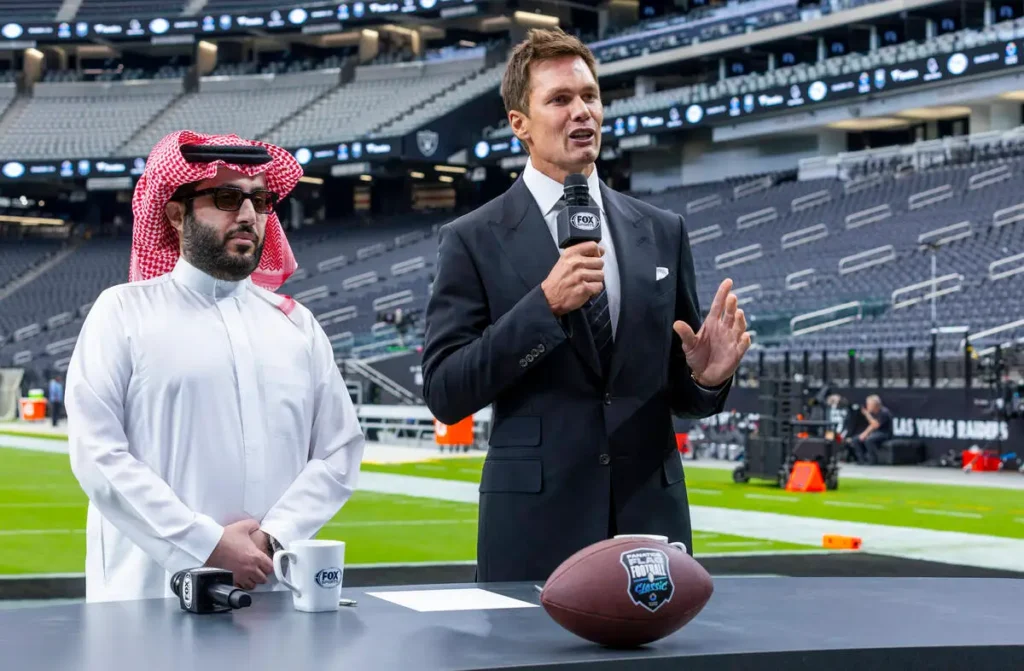📸 Image Credit: (L.E. Baskow/Las Vegas Review-Journal) @Left_Eye_Images
Expanding Beyond Soccer
Saudi Arabia has already transformed the global soccer market with high-profile signings and massive investments. Now, the Kingdom is signaling interest in a different sport: American football. With a flag football showcase scheduled in Riyadh in 2026, Saudi Arabia is testing whether the energy and spectacle of the NFL can resonate with fans in the Middle East.
This move reflects the broader ambitions of Vision 2030, the national strategy designed to diversify the economy and strengthen Saudi Arabia’s cultural influence worldwide.
Why Saudi Arabia is Turning Toward American Football
The decision to bring flag football into the spotlight is not random. It ties into three major goals:
- Global Branding: Hosting international sports helps Saudi Arabia position itself as a global hub.
- Youth Development: Flag football is safe, fast-paced, and easy for schools to adopt.
- Olympic Momentum: With flag football joining the 2028 Summer Olympics, Saudi Arabia wants to establish a strong presence early.
The choice of flag football, rather than traditional tackle football, reflects practicality. It requires less infrastructure, carries fewer risks, and is easier to introduce in a country where American football is still niche.
The Riyadh Flag Football Classic: What to Expect
The Riyadh showcase, planned for March 2026, will feature a mix of current and retired professional athletes. Teams will compete under flag football rules, where pulling a flag replaces tackling. This format emphasizes strategy and speed while making the game more inclusive.
The event is part of Riyadh Season, the Kingdom’s annual sports and entertainment festival, which already hosts international stars across multiple disciplines. By adding flag football, organizers are betting on a fresh spectacle that appeals to both local audiences and global fans.
A Natural Fit for Vision 2030
Saudi Arabia’s move into flag football is part of a larger pattern of investment in sports:
- Tourism & Economy: International tournaments attract visitors, boosting hotels, restaurants, and local businesses.
- Diversity of Offerings: Beyond soccer and motorsports, adding American football showcases variety.
- Youth Engagement: The safer, less complex nature of flag football makes it ideal for schools and academies.
- Gender Inclusivity: Because of reduced contact, flag football is played widely by both men and women, aligning with broader social reforms.
What the Fanatics Flag Football Classic Will Look Like
| Feature | Details |
|---|---|
| Date & Location | March 21, 2026 — Kingdom Arena, Riyadh, Saudi Arabia |
| Teams & Players | Three teams combining current and former NFL stars (Tom Brady, Rob Gronkowski, etc.) |
| Coaches | Pete Carroll, Sean Payton, Kyle Shanahan |
| Format | Round-robin among three teams, followed by a championship match. Smaller team size, Olympic style rules. |
| Broadcast & Hosts | FOX Sports will televise; comedian Kevin Hart as host. |
Challenges Facing American Football in Saudi Arabia
While the potential is strong, challenges remain:
- Limited Awareness: Soccer dominates regional sports culture, and American football is still unfamiliar to many.
- NFL Restrictions: The league has strict ownership rules that limit direct foreign or state-backed investment in teams.
- Sustained Popularity: One showcase can spark excitement, but long-term engagement requires leagues, academies, and consistent fan outreach.
Still, Saudi Arabia’s track record with soccer and golf suggests that major investment, international partnerships, and strong marketing could overcome these barriers.
What This Means for the NFL and Beyond
The Riyadh showcase is not an official NFL game, but it is connected to the sport’s growing global ambitions. The NFL has already staged games in London, Germany, and Mexico. If Saudi Arabia proves a viable market, the region could become part of the league’s international roadmap.
Looking further ahead:
- Exhibition Matches: NFL preseason or Pro Bowl-style events could take place in the Middle East.
- Regional Leagues: Flag football could serve as the foundation for youth and amateur competitions.
- Olympic Participation: Saudi Arabia could field competitive teams by 2028, supported by government investment.
Conclusion: A First Step Toward a Bigger Goal
Saudi Arabia’s decision to host a major flag football event in 2026 may seem like a small step compared to its soccer dominance, but it could have significant implications. By introducing a safer, faster version of American football, the Kingdom is building pathways for youth, international cooperation, and long-term growth.
Whether or not Saudi Arabia ever hosts a full NFL matchup, its NFL ambitions are clear. Just as it redefined soccer’s global landscape, the Kingdom could one day play a pivotal role in shaping the future of American football beyond U.S. borders.

